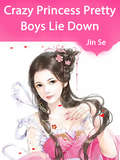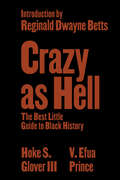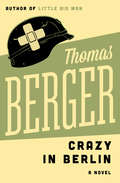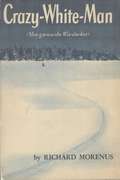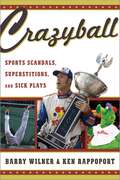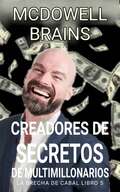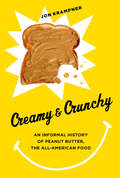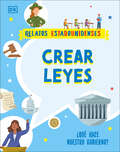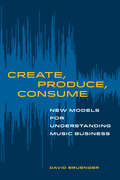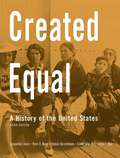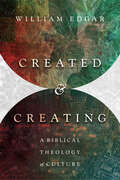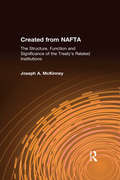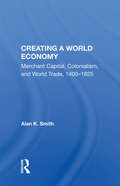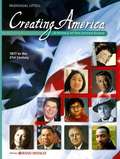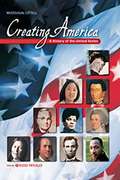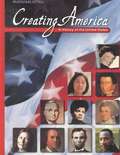- Table View
- List View
Crazy Princess: Volume 3 (Volume 3 #3)
by Jin SeThe eldest miss of the Residence of General's' Pig Demons' had been resurrected and attacked with her heaven-defying transformation. She swore to not talk about her children's love affairs, but to seek revenge for her blood! But … Young Lord Mo, who was pretending to be a pig to eat the tiger; Senior Brother Xiao Ran, who was extremely shrewd; Young Master Yue, who was mysterious and gloomy; and Demon Lord Mo, who was amicable and protective … What do these beautiful men mean by lying in a line? What kind of tempo was it to take off your clothes at a single word? Was it just a brain-teasing way of saying that he was a girl or a girl whenever he wanted to? Since all the beauties are taking the initiative, then this little girl will … Hehehehe!
Crazy Princess: Volume 4 (Volume 4 #4)
by Jin SeThe eldest miss of the Residence of General's' Pig Demons' had been resurrected and attacked with her heaven-defying transformation. She swore to not talk about her children's love affairs, but to seek revenge for her blood! But … Young Lord Mo, who was pretending to be a pig to eat the tiger; Senior Brother Xiao Ran, who was extremely shrewd; Young Master Yue, who was mysterious and gloomy; and Demon Lord Mo, who was amicable and protective … What do these beautiful men mean by lying in a line? What kind of tempo was it to take off your clothes at a single word? Was it just a brain-teasing way of saying that he was a girl or a girl whenever he wanted to? Since all the beauties are taking the initiative, then this little girl will … Hehehehe!
Crazy River: Exploration and Folly in East Africa
by Richard GrantNO ONE TRAVELS QUITE LIKE RICHARD GRANT and, really, no one should. In his last book, the adventure classic God's Middle Finger, he narrowly escaped death in Mexico's lawless Sierra Madre. Now, Grant has plunged with his trademark recklessness, wit, and curiosity into East Africa. Setting out to make the first descent of an unexplored river in Tanzania, he gets waylaid in Zanzibar by thieves, whores, and a charismatic former golf pro before crossing the Indian Ocean in a rickety cargo boat. And then the real adventure begins. Known to local tribes as "the river of bad spirits," the Malagarasi River is a daunting adversary even with a heavily armed Tanzanian crew as travel companions. Dodging bullets, hippos, and crocodiles, Grant finally emerges in war-torn Burundi, where he befriends some ethnic street gangsters and trails a notorious man-eating crocodile known as Gustave. He concludes his journey by interviewing the dictatorial president of Rwanda and visiting the true source of the Nile. Gripping, illuminating, sometimes harrowing, often hilarious, Crazy River is a brilliantly rendered account of a modern-day exploration of Africa, and the unraveling of Grant's peeled, battered mind as he tries to take it all in.
Crazy as Hell: The Best Little Guide to Black History
by Hoke S. Glover III V. Efua PrinceBy turns hilarious, candid, and heartbreaking, this powerful book takes the straitjacket off Black history. A refreshing, insightful, sacrilegious take on African American history, Crazy as Hell explores the site of America’s greatest contradictions. The notables of this book are the runaways and the rebels, the badass and funky, the activists and the inmates—from Harriet Tubman, Nina Simone, and Muhammad Ali to B’rer Rabbit, Single Mamas, and Wakandans—but are they crazy as hell, or do they simply defy the expectations designated for being Black in America? With humor and insight, scholars and writers V. Efua Prince and Hoke S. Glover III (Bro. Yao) offer brief breakdowns of one hundred influential, archetypal, and infamous figures, building a new framework that emphasizes their humanity. Including an introduction by MacArthur Fellow Reginald Dwayne Betts and peppered with little-known historical facts and PSAs that get real about the Black experience, Crazy as Hell captures the tenacious, irreverent spirit that accompanies a long struggle for freedom.
Crazy in Berlin: A Novel (Carlo Reinhart #1)
by Thomas BergerThomas Berger&’s debut novel of a young man tumultuously coming of age in postwar GermanyCarlo Reinhart, a young American army medic stationed in Germany, confronts a disturbing new world following the end of World War II. Living in Berlin, a city fractured into barricaded sectors by the occupying powers, Reinhart begins to drive himself mad with memories of the evils he has witnessed and questions about how the atrocities took place. When he meets an idealistic Jew named Nathan Schild, Reinhart&’s turmoil grows more acute. Schild works for both the Americans and the Russians, and he becomes a flashpoint for Reinhart&’s anguish over the world&’s vast contradictions. When Schild&’s escapades lead to a powerful turning point, Reinhart is forced to come to terms with life&’s ambiguities as well as with his own evolving identity. This ebook features an illustrated biography of Thomas Berger including rare images and never-before-seen documents from the author&’s personal collection.
Crazy-White-Man (Sha-ga-na-she Wa-du-kee)
by Richard MorenusThe author was a businessman from New York who got tired of the "Big City" life and was unhappy for some time. He decided to move as far away from that environment. Taking only his dog, some gear, and an open heart he travelled to Canada. During this trip, he found an island of epic beauty and decided to purchase it. His story tells of his difficulty trying to adapt to such the harsh environment. The local population were Native Americans who gave him the name "Crazy White Man" for making the changes that he did.Dick Morenus, New York radio and magazine writer, took to the Ontario bush country to shed his ulcers. After writing this hilarious account of his six-year transition from tenderfoot to woodsman-guide, he returned to city life to teach, write, and lecture,CHICAGO TRIBUNE -- "As a story of the indomitable spirit of men and women pitted against the overwhelming forces of nature, 'Crazy-White-Man' is an inspiring one; as a tale of pure adventure, it will be hard to put down ... a book that is a little classic of the rugged life."CHRISTIAN SCIENCE MONITOR -- " ... one of the best tales of escape from city pressures ... It is a vivid close-up of the Ontario bush--written down with the vividness and gaiety of a man who knew he was free."NEW YORK TIMES -- "Respect for Mr. Morenus' courage and hardihood grows with every page we read . . . it emerges as a valuable addition to the small number of books about the Canadian bush."COLORADO SPRINGS FREE PRESS -- "Anyone from young to old who has wanted to toss the soft life of today into the discard and live as our ancestors did will enjoy this book. To those who have lived under frontier conditions it will be equally refreshing--and that cannot be said for many of this type."
Crazyball: Sports Scandals, Superstitions, and Sick Plays
by Ken Rappoport Barry WilnerCrazyball is a look at the wild, unusual, unimaginable, funny, and downright strange occurrences in sports. Barry Wilner and Ken Rappoport take us from the worst teams in history to sports&’ craziest superstitions, wackiest pranks, and ultimate blown calls. This book is filled with moments that will make you laugh, shake your head in wonderment, lose your breath, or simply ask: &“Really?!&”
Creadores de secretos de multimillonarios (La Brecha De Cabal Libro 5 #5)
by McDowell BrainsCreadores secretos de multimillonarios Siva se encuentra en problemas cuando llega una oferta tentadora que lo convertiría en multimillonario en veinticuatro horas. En un hotel pequeño pero muy caro de la capital del país, se acaba de anunciar que un especialista en investigación, llamado Siva, es el próximo en convertirse en multimillonario. Un grupo poderoso y despiadado lo nominó cuando viaja por el país luchando contra el saqueo y el lavado de dinero. Pero Siva no necesitaría mil quinientos millones para descontinuar el caso del escándalo monetario, al que están vinculados muchos nombres, de un candidato presidencial que murió bajo custodia policial. Sin embargo, con esto, Siva obtiene mucho más de lo que negocia. Sus donantes de mil quinientos millones asesinaron al político, están vinculados al escándalo y no quieren ver a Siva en vivo. Usarán a Siva, primero, para ubicar a los traidores entre ellos, luego, lo matarán sin pensarlo dos veces.
Creamy & Crunchy: An Informal History of Peanut Butter, the All-American Food (Arts and Traditions of the Table Perspectives on Culinary History)
by Jon Krampner&“A delightful book about America&’s most popular nut butter and sandwich spread . . . well-written, fast-paced, surprising.&”—Andrew F. Smith, editor in chief, The Oxford Encyclopedia of Food and Drink in America Americans spoon it out of the jar, eat it in sandwiches by itself or with its bread-fellow jelly, and devour it with foods ranging from celery and raisins (&“ants on a log&”) to a grilled sandwich with bacon and bananas (the classic &“Elvis&”). Peanut butter is used to flavor candy, ice cream, cookies, cereal, and other foods. It is a deeply ingrained staple of American childhood. Along with cheeseburgers, fried chicken, chocolate chip cookies (and apple pie), peanut butter is a consummate comfort food. In Creamy and Crunchy are the stories of Jif, Skippy, Peter Pan; the plight of black peanut farmers; the resurgence of natural or old-fashioned peanut butter; the reasons why Americans like peanut butter better than (almost) anyone else; the five ways that today&’s product is different from the original; the role of peanut butter in fighting Third World hunger; and the Salmonella outbreaks of 2007 and 2009, which threatened peanut butter&’s sacred place in the American cupboard. To a surprising extent, the story of peanut butter is the story of twentieth-century America, and Jon Krampner writes its first popular history, rich with anecdotes and facts culled from interviews, research, travels in the peanut-growing regions of the South, personal stories, and recipes. &“A witty, encyclopedic history of one of America&’s most iconic processed foods. It is chock-full of fun facts and surprising insights into the way we eat today.&”—Aaron Bobrow-Strain, author of White Bread: A Social History of the Store-Bought Loaf
Creamy and Crunchy: An Informal History of Peanut Butter, the All-American Food (Arts and Traditions of the Table: Perspectives on Culinary History)
by Jon KrampnerMore than Mom's apple pie, peanut butter is the all-American food. With its rich, roasted-peanut aroma and flavor; caramel hue; and gooey, consoling texture, peanut butter is an enduring favorite, found in the pantries of at least 75 percent of American kitchens. Americans eat more than a billion pounds a year. According to the Southern Peanut Growers, a trade group, that's enough to coat the floor of the Grand Canyon (although the association doesn't say to what height).Americans spoon it out of the jar, eat it in sandwiches by itself or with its bread-fellow jelly, and devour it with foods ranging from celery and raisins ("ants on a log") to a grilled sandwich with bacon and bananas (the classic "Elvis"). Peanut butter is used to flavor candy, ice cream, cookies, cereal, and other foods. It is a deeply ingrained staple of American childhood. Along with cheeseburgers, fried chicken, chocolate chip cookies (and apple pie), peanut butter is a consummate comfort food. In Creamy and Crunchy are the stories of Jif, Skippy, Peter Pan; the plight of black peanut farmers; the resurgence of natural or old-fashioned peanut butter; the reasons why Americans like peanut butter better than (almost) anyone else; the five ways that today's product is different from the original; the role of peanut butter in fighting Third World hunger; and the Salmonella outbreaks of 2007 and 2009, which threatened peanut butter's sacred place in the American cupboard. To a surprising extent, the story of peanut butter is the story of twentieth-century America, and Jon Krampner writes its first popular history, rich with anecdotes and facts culled from interviews, research, travels in the peanut-growing regions of the South, personal stories, and recipes.
Crear leyes: ¿Qué hace nuestro gobierno? (Relatos estadounidenses)
by DKInspira jóvenes curiosos a explorar el impacto del gobierno a lo largo de la historia de la nación y cómo es la vida en EE. UU. hoy en día: Parte de una serie inspirante que apoya el aprendizaje acerca del gobierno y el civismo en un EE. UU. contemporáneo a través de eventos históricos y las personas que formaron los mismos. Crear leyes interconecta contexto,personalidades y eventos históricos y las experiencias de estadounidenses modernos. Ayudará los estudiantes a entender temas claves de estudios sociales, como los orígenes de instituciones y valores de EE. UU. y la relevancia que tienen a las vidas de jóvenes hoy. El libro explora el impacto del gobierno en la vida diaria, incluyendo cobrar impuestos, seguridad, proteger los derechos de ciudadanos, organizar y proveer servicios. La autora explica la función de otras entidades, como el gobierno estatal. Temas y eventos históricos incluyen ejemplos de varias funciones del gobierno: seguridad en tiempos de guerra, prestación de servicios y ayudando a los más necesitados.
Create, Produce, Consume: New Models for Understanding Music Business
by David BruengerCreate, Produce, Consume explores the cycle of musical experience for musicians, professionals, and budding entrepreneurs looking to break into the music industry. Building on the concepts of his previous book, Making Money, Making Music, David Bruenger provides readers with a basic framework for understanding the relationships between the artist and audience and the producer consumer by examining the methods underlying creation-production-reception and creation-consumption-compensation. Each chapter offers a different perspective on the processes and structures that lead listeners to discover, experience, and interact with music and musical artists. Through case studies ranging from Taylor Swift’s refusal to allow her music to be streamed on Spotify to the rise of artists supported through sites like Patreon, Bruenger offers highly relevant real-world examples of industry practices that shape our encounters with music. Create, Produce, Consume is a critical tool for giving readers the agile knowledge necessary to adapt to a rapidly changing music industry. Graphs, tables, lists for additional reading, and questions for further discussion illustrate key concepts. Online resources for instructors and students will include sample syllabi, lists for expanded reading, and more.
Created Equal: A History of the United States (3rd Edition)
by Jacqueline Jones Elaine Tyler May Thomas Borstelmann Peter H. Wood Vicki L. RuizWith its sweeping, inclusive view of American history, Created Equal emphasizes social history--including the lives and labors of women, immigrants, working people, and minorities in all regions of the country--while delivering the familiar chronology of political and economic history. By integrating the stories of a variety of groups and individuals into the historical narrative, Created Equal helps connect the nation's past with the student's present. Created Equal explores an expanding notion of equality and American identity--one that encompasses the stories of diverse groups of people, territorial growth and expansion, the rise of the middle class, technological innovation and economic development, and engagement with other nations and peoples of the world.
Created Equal: A History of the United States, Volume 2
by Elaine Tyler May Thomas Borstelmann Peter H. Wood Vicki L. Ruiz Jacqueline A. JonesRe-examines American History through the theme of contested equality Taking an inclusive view of American history, Created Equal emphasizes the struggles for equality experienced by diverse groups of Americans across the many regions of the nation With a steadfast chronological framework, and a strong narrative thread, the authors offer a fresh and critical perspective on the traditional story. MyHistoryLab is an integral part of the Jones program. Key learning applications include assessment, MyHistoryLab Video Series, and History Explorer A better teaching and learning experience This program will provide a better teaching and learning experience-for you and your students. Here's how: Personalize Learning -- Personalize Learning -- MyHistoryLab is an online homework, tutorial, and assessment program. It helps students prepare for class and instructor gauge individual and class performance. Emphasize Outcomes -- Learning Objective Questions at the beginning of each chapter and a chapter review and thematic timeline ending each chapter keep students focused on what they need to know On MyHistoryLab, practice tests help students achieve these objectives by measuring progress and creating personalized study plans. Engage Students -- A new pedagogically-driven design highlights a clear learning path through the material and offers a visually stunning learning experience in print or on a screen. With the Pearson eText, students can transition directly to MyHistoryLab resources such as primary source documents, videos, and mapping exercises. Improve Critical Thinking -- Powerful learning applications in MyHistoryLab including Explorer mapping exercises, Closer Look analyses of sources and topics, and Writing Assessments tied to engaging videos-promote critical thinking Support Instructors -- MyHistoryLab, Instructor's eText, MyHistoryLab Instructor's Guide, Class Preparation Tool, Instructor's Manual, MyTest, and PowerPoints are available. This Book a la Carte Edition is an unbound, three-hole punched, loose-leaf version of the textbook and provides students the opportunity to personalized their book by incorporating their own notes and taking the portion of the book they need to class - all at a fraction of the bound book price
Created Equal: The Painful Past, Confusing Present, and Hopeful Future of Race in America
by Ben CarsonIn this inspiring New York Times bestseller, conservative icon Dr. Ben Carson lays out a hopeful road map for how America can come together. External physical characteristics that are genetically encoded are things over which no individual has control. But rather than appreciating the gift of diversity, some have chosen to use it to drive wedges between groups of people. Some of these external characteristics are associated with the past moral failing of slavery. Though slavery in America formally ended in the 1860s, the vestiges of that evil institution are still with us today, and those vestiges often inflict guilt on some and facilitate feelings of victimhood in others. In Created Equal, Dr. Carson uses his own personal experiences as a member of a racial minority, along with the writings and experiences of others from multiple backgrounds and demographics, to analyze the current state of race relations in America. Instead of using race as an excuse to remake America into something completely antithetical to the Constitution, Dr. Carson suggests ways to enhance and bring great success to our nation and all multiethnic societies by magnifying America's incredible strengths instead of her historical weaknesses.
Created and Creating: A Biblical Theology of Culture
by William EdgarThe gospel of Jesus Christ is always situated within a particular cultural context. But how should Christians approach the complex relationship between our faith and our surrounding culture? Should we simply retreat from culture? Should we embrace our cultural practices and mindset? How important is it for us to be engaged in our culture? And how might we do that with discernment and faithfulness? William Edgar offers a rich biblical theology in light of our contemporary culture that contends that Christians should—indeed, must—be engaged in the surrounding culture. By exploring what Scripture has to say about the role of culture and by gleaning insights from a variety of theologians of culture—including Abraham Kuyper, T. S. Eliot, H. Richard Niebuhr, and C. S. Lewis—Edgar contends that cultural engagement is a fundamental aspect of human existence. He does not shy away from those passages that emphasize the distinction between Christians and the world. Yet he finds, shining through the biblical witness, evidence that supports a robust defense of the cultural mandate to "be fruitful and multiply, and fill the earth and subdue it," (Genesis 1:28). With clarity and wisdom, Edgar argues that we are most faithful to our calling as God's creatures when we participate in creating culture.
Created from NAFTA: The Structure, Function and Significance of the Treaty's Related Institutions
by Joseph A. McKinneyThe North American Free Trade Agreement involved much more than simple trade barrier reduction. This volume provides an in-depth examination and analysis of the structure, functions, and performance of the NAFTA institutions from their inception.
Created in China: The Great New Leap Forward (Media, Culture and Social Change in Asia)
by Michael KeaneThis book examines China’s creative economy—and how television, animation, advertising, design, publishing and digital games are reshaping traditional understanding of culture. Since the 1950s China has endeavoured to catch-up with advanced Western economies. ‘Made in China’ is one approach to global competitiveness. But a focus on manufacturing and productivity is impeding innovation. China imports creativity and worries about its ‘cultural exports deficit’. In the cultural sector Chinese audiences are attracted to Korean, Taiwanese, and Japanese culture, as well as Hollywood cinema. This book provides a fresh look looks at China’s move up the global value chain. It argues that while government and (most) citizens would prefer to associate with the nationalistic, but unrealized ‘created in China’ brand, widespread structural reforms are necessary to release creative potential. Innovation policy in China has recently acknowledged these problems. It considers how new ways of managing cultural assets can renovate largely non-competitive Chinese cultural industries. Together with a history of cultural commerce in China, the book details developments in new creative industries and provides the international context for creative cluster policy in Beijing and Shanghai.
Creating A Confederate Kentucky The Lost Cause and Civil War Memory in A Border State
by Anne E. MarshallHistorian E. Merton Coulter famously said that Kentucky "waited until after the war was over to secede from the Union. " In this fresh study, Anne E. Marshall traces the development of a Confederate identity in Kentucky between 1865 and 1925 that belied the fact that Kentucky never left the Union and that more Kentuckians fought for the North than for the South. Following the Civil War, the people of Kentucky appeared to forget their Union loyalties, embracing the Democratic politics, racial violence, and Jim Crow laws associated with formerly Confederate states. Although, on the surface, white Confederate memory appeared to dominate the historical landscape of postwar Kentucky, Marshall's closer look reveals an active political and cultural dialogue that included white Unionists, Confederate Kentuckians, and the state’s African Americans, who, from the last days of the war, drew on Union victory and their part in winning it to lay claim to the fruits of freedom and citizenship. Rather than focusing exclusively on postwar political and economic factors,Lost Cause, Gained Identitylooks at Kentuckians' activities--public memorial ceremonies, dedications of monuments, and veterans organizations' events--over the longer term, by which they commemorated the Civil War and fixed the state's remembrance of it for sixty years following the conflict. Historian E. Merton Coulter famously said that Kentucky "waited until after the war was over to secede from the Union. " In this fresh study, Anne E. Marshall traces the development of a Confederate identity in Kentucky between 1865 and 1925 that belied the fact that Kentucky never left the Union and that more Kentuckians fought for the North than for the South. Following the Civil War, the people of Kentucky appeared to forget their Union loyalties, embracing the Democratic politics, racial violence, and Jim Crow laws associated with formerly Confederate states. Although, on the surface, white Confederate memory appeared to dominate the historical landscape of postwar Kentucky, Marshall's closer look reveals an active political and cultural dialogue that included white Unionists, Confederate Kentuckians, and the state’s African Americans, who, from the last days of the war, drew on Union victory and their part in winning it to lay claim to the fruits of freedom and citizenship. Rather than focusing exclusively on postwar political and economic factors,Lost Cause, Gained Identitylooks at Kentuckians' activities--public memorial ceremonies, dedications of monuments, and veterans organizations' events--over the longer term, by which they commemorated the Civil War and fixed the state's remembrance of it for sixty years following the conflict.
Creating A Hoosier Self-Portrait: The Federal Writers' Project in Indiana, 1935–1942
by George T. BlakeyThe story of the New Deal program that helped to preserve the history and cultural heritage of Indiana during the Great Depression.From 1935 to 1942, the Indiana office of the Federal Writers’ Program hired unemployed writers as “field workers” to create a portrait in words of the land, the people, and the culture of the Hoosier state. This book tells the story of the project and its valuable legacy. Beginning work under the guidance of Ross Lockridge, whose son would later burst onto the American literary scene with his novel Raintree County, the group would eventually produce Indiana: A Guide to the Hoosier State, Hoosier Tall Stories, and other publications. Though many projects were never brought to completion, the Program’s work remains a useful and rarely tapped storehouse of information on the history and culture of the state.“An important history of the Indiana state Federal Writers’ Project . . . straightforward . . . persuasive . . . impassioned. This is an important social history of Depression-era Indiana and a guide for future research.” —A. B. Audant, CUNY Kingsborough Community College
Creating A World Economy: Merchant Capital, Colonialism, And World Trade, 1400-1825
by Alan K. SmithThis is an exploration in world history that examines complex and intriguing questions concerning the origins of the first truly global economy, centered in Europe, which served in turn as a solid basis for the later emergence of the modern world system. Professor Smith first examines the remarkable progress achieved by many cultures around the world, achievements that for some time far exceeded anything then found in Europe. The study then probes beyond "traditionalism" as a sufficient explanation of the inability of these societies to maintain the economic momentum that had begun so auspiciously and carefully examines the experience of European societies by way of comparison, finding that remarkably similar processes tended to unfold at first: regions of Europe that made the earliest gains in material progress were, like other parts of the world, unable to sustain these advances. Still, in some parts of Europe–particularly the Netherlands and England–a new alignment of social forces was yielding the social system that would eventually evolve into capitalism. This breakthrough allowed for continued dynamic material progress, particularly for the English. Able to establish an unprecedented commercial dominance in vast reaches of the world, the British found themselves at the hub of a new world economy much more complex than any earlier intercultural commercial system. The book delineates the systemic roles assumed by the various regions of the world and by European merchant capital and explains the tensions within this system that ensured its continued dynamism and eventual transformation into the current world economic system. Creating a World Economy combines an epic sweep with a mastery of historical detail and is sure to stimulate discussion among sociologists and historians interested in questions of a global nature.
Creating America, A History of the United States, 1877 to the 21st Century
by Donna M. Ogle Jesus Garcia C. Frederick RisingerNIMAC-sourced textbook
Creating America: A History of the United States
by Donna M. Ogle Jesus Garcia C. Frederick RisingerNIMAC-sourced textbook
Creating America: A History of the United States
by Donna M. Ogle Jesus Garcia C. Frederick Risinger Joyce Stevos Winthrop D. JordanA textbook on the history and evolution of America.
Creating America: A History of the United States
by Donna M. Ogle Jesus Garcia C. Frederick Risinger Joyce StevosCreating America: A History Of The United States, with an atlas by Rand McNally
